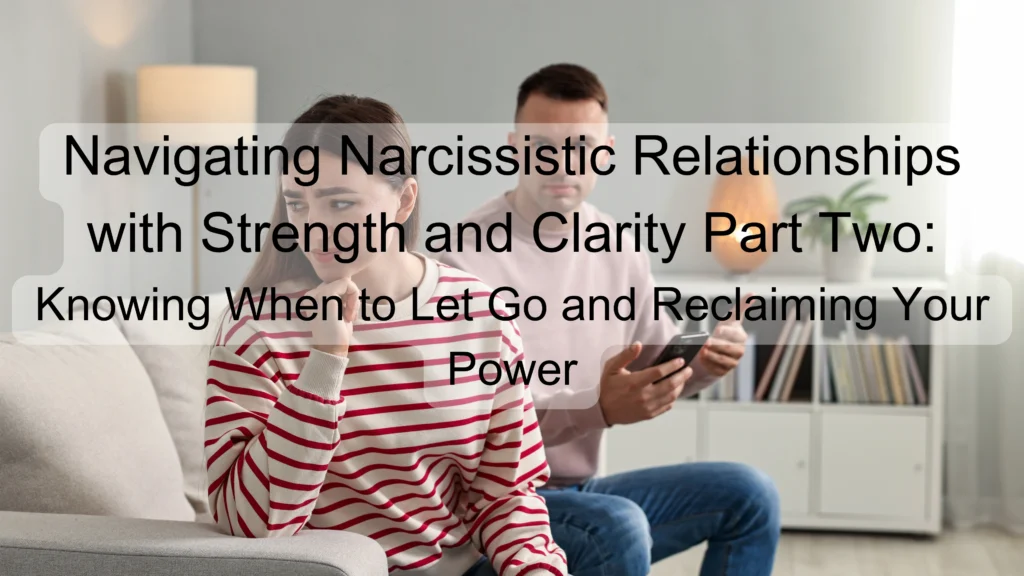Navigating Narcissistic Relationships with Strength and Clarity Part Two:
Knowing When to Let Go and Reclaiming Your Power
In Part One, we explored the subtle difference between healthy and unhealthy narcissism, the importance of setting and holding boundaries, and how to stay empathic without erasing yourself. All of this is foundational. But even with this clarity, one question often lingers in the hearts of those who’ve been deeply hurt:
“Can they change?”
“Should I stay and hope?”
“How do I know when it’s time to leave?”
Let’s gently, but truthfully, walk through this together.
Tool 4: Know When to Walk Away
This is the hardest truth, and yet the most liberating one: not everyone will grow with us.
In Rethinking Narcissism, Dr. Craig Malkin offers hope—but also realism. He affirms that some individuals with narcissistic traits can change. If they are not at the extreme end of the spectrum, possess a spark of insight, are open to feedback, and are willing to undertake deep inner work, they can grow. However, this is crucial, only if they genuinely wish to.
And many do not.
This is where it becomes dangerous for those who are deeply empathic, hopeful, and accustomed to giving people the benefit of the doubt. We may hold on for years—waiting, hoping, bargaining, explaining, and trying harder. We confuse trauma bonding with love and mistake our capacity to endure for a virtue when it is, in fact, a cry for help.
There comes a moment—a still, sober moment—when you realise:
You are doing all the work.
You are the one bending, accommodating, and compromising.
And they are not meeting you in the middle—not even close.
That’s when you must ask the question, not with judgment, but with wisdom:
What is the cost of staying?
Is it your sleep?
Your self-esteem?
Physical health?
The peace of mind of your children?
Your dreams, your career, your voice?
It is too high if the cost of being in the relationship is your very self.
Walking away is not about giving up on someone; it’s about choosing yourself, choosing life, choosing sanity, and choosing peace.
And no matter how long you’ve stayed, how much you’ve invested, or how much they plead, you are allowed to leave.
You are allowed to change the ending.
Rebuilding After Narcissistic Harm: The Return to Self
Leaving or healing from a narcissistic relationship doesn’t just mean moving on physically. The real work begins inside. It is the work of returning to yourself, sometimes after years of abandonment, neglect, or self-doubt.
You may find yourself unsure of your own thoughts. You might second-guess everything. This is normal. Narcissistic abuse scrambles our inner compass. Rebuilding means learning to trust your body, voice, and intuition.
Start small. Honour your need for rest. Speak kindly to yourself. Engage in activities that bring you joy, even if they seem a tad silly. Spend time with those who uplift you, not drain you. Begin to reclaim your life once more, rather than existing as a character in someone else’s drama.
You might also notice a fear of being “too much” or “too needy.” This is the echoism Malkin describes—the other end of the narcissism spectrum. Many survivors diminish themselves to avoid conflict. Part of your healing involves reclaiming your right to be seen, heard, and celebrated.
You are not a burden, you’re not too emotional. You are not broken, you’re healing and evolving and you’re becoming whole.
There Is Life Beyond This
To my dear ones in the Rebuild Your Life community—know this: there is life beyond the confusion, the gaslighting, and the dry emptiness of a relationship built on control.
There is life where you are not constantly explaining yourself.
There’s life where your joy doesn’t threaten someone else’s insecurity.
There is life where your empathy is met, your boundaries are respected, and your love flows freely, not fearfully.
Reclaiming your power after narcissistic harm is not merely a recovery—it is a resurrection. You are rising from the ashes you never asked to be buried in. Yet, you are rising nonetheless.
Let the process be sacred, the truth set you free. Let this be the moment where everything begins to change.
Wondering what to read next? Why not try When Sobriety Looks Like a “Dry Drunk”

